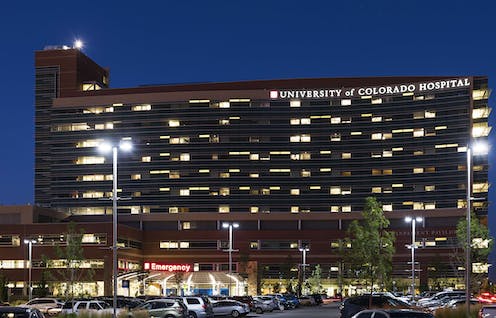
Does living near a hospital make you more likely to get the health care you need?
Even though the federal government requires nonprofit hospitals to regularly assess the health needs of their surrounding communities and publicly post a plan to address those concerns, many people living nearby struggle to get basic health care.
We are a political scientist and an urban sociologist who study how hospitals interact with and shape the communities in which they are located. As we explain in our book, “The City and the Hospital,” most top-ranked hospitals in the U.S. aren’t doing enough in this regard.
Table of Contents
A paradox for local communities
Despite living in the shadow of world-class medical facilities, people residing in these communities often have poor health.
We call this the paradox of medically overserved communities.
Many nonprofit hospitals amass revenues in the millions and even billions. This economic power, coupled with their stated missions to take care of their local community, positions most of them well to benefit the neighborhoods surrounding their campuses.
Urban hospitals tend to be centrally located; residents of these city centers tend to be low income, and many of them are disproportionately Black and Latino. Using census data, we found that the neighborhoods around our case sites were, overall, less white, had lower household incomes, lower property values and greater vacancy rates than the rest of their cities. They also had worse health.
Worse off in terms of health
To better understand how hospitals serve local populations, we and our colleague, medical sociologist Berkeley Franz, conducted over 200 interviews.
We spoke with local residents, hospital administrators, business owners and health care advocates. Our conversations focused on three American hospitals: the Cleveland Clinic in Ohio, Hartford Hospital in Connecticut and the University of Colorado Hospital in Aurora. Like these three, about half of U.S. hospitals are nonprofits.
In all three cities, these neighborhoods had lower rates of health insurance compared with citywide and national averages. And so, when looking at a map, these neighborhoods might appear to have greater access to health care than, for example, those living in rural communities. This is not the case.
We found that Americans residing in a census tract next to those three hospitals were actually more likely to be in poorer health than their fellow city dwellers.
We examined 12 key health conditions, including heart disease, high blood pressure, diabetes, high cholesterol and mental illness. Local residents were faring worse than city averages 64% of the time and worse than national averages 80% of the time.

SDI Productions/E+ via Getty Images
Vague mandate
Nonprofit hospitals get tax exemptions because the Internal Revenue Service recognizes that the promotion of health is a charitable mission that serves the public good. Because for-profit hospitals pay all applicable taxes, they are not subject to these IRS requirements.
Nonprofit hospitals save billions every year in federal, state and local taxes. But they are required to spend some of their money to provide what the government calls “community benefit.”
How much should these hospitals spend?
Until now, the authorities have not specified an amount or percentage of a hospital’s revenues or profits. The IRS test for community benefit is vague. It requires that hospitals make “investments” that are “broad enough to benefit the community” and must “serve a public rather than a private interest.”
Although providing charity care isn’t the only contribution hospitals make to their communities, it’s an important one. And in 2020, when the question was last looked at closely, nonprofit hospitals’ charity care totaled US$16 billion – during a year when they got $28.1 billion in tax breaks.
Some hospitals do little to nothing to meet this goal. The U.S. Government Accountability Office, a government watchdog, found 30 nonprofit hospitals that got tax breaks in 2016 despite reporting no spending on community benefits at all.
And although hospitals are required to report their community benefit activities to the IRS every three years, the government agency “was unable to provide evidence that it did so because it did not have a well-documented process to ensure those activities were being reviewed,” the GAO said in 2023.
Community benefit
People living near hospitals complained, as you might expect, about blaring sirens, helicopters and traffic. We also heard confusion over hospitals’ responsibilities toward their local community.
Local residents often told us they expected more from hospitals than other neighborhood institutions. As Mansfield Frazier, a Cleveland community advocate, put it, the Cleveland Clinic is “not in the business of making widgets. They’re in the business of promoting health.”
On the other hand, hospital administrators at the three hospitals we studied insist that they spend generously to improve their local communities. One Cleveland Clinic administrator, for example, lamented, “There are some people who think it is our job to repair potholes on their streets.”
In terms of “how well hospitals invest in community health,” a health-focused think tank, the Lown Institute,
graded our three hospitals as average: Hartford Hospital earned a B grade, and the University of Colorado Hospital and the vaunted Cleveland Clinic both earned a C.
The American Hospital Association has responded to these assessments by criticizing Lown’s methods and data. Most notably, it accuses Lown of “cherry-picking,” insisting that delivering “life-saving treatments” and educating newly graduated physicians should be considered part of “community benefit.” Such activities are generally not considered part of hospitals’ broader nonprofit obligations because they are paid for the medical care they deliver and the physicians they train.
‘Appetite for land’
Residents of the three neighborhoods where we conducted our research often noted their local hospital’s prominence. But they also said they felt unwelcome there, using words like “behemoth,” “intimidating” and “imposing” when describing them.
They also told us they were upset when the hospitals purchased neighborhood homes and other buildings and razed them for new facilities. In Hartford, residents pointed to an example of how the hospital bought a family-run funeral home that had catered to the local Latino community and then turned it into a parking lot.
The local community expressed similar concerns about the Cleveland Clinic’s “appetite for land,” which threatened the future of the neighborhood’s historic churches.
We also heard concerns over unfair billing practices that echoed what The New York Times has found – that overcharging patients entitled to free care is perhaps more common than previously believed.
In all three communities, people told us they avoided their local, prominent hospitals because of fears of the financial burden a visit would yield. Many local residents said they saw less celebrated hospitals that were farther from home as safer options in terms of what they expected to pay.
An unfulfilled promise
When Congress passed the Affordable Care Act in 2010, it reasserted the idea that nonprofit hospitals should provide substantial benefits to communities in exchange for their tax exemptions. That hasn’t happened.
Scholars widely agree there’s no evidence that nonprofit hospitals have generally done more to benefit their local communities with the ACA than they did without it.
Yet a lack of oversight has meant that hospitals have rarely faced penalties for noncompliance.
![]()
The authors do not work for, consult, own shares in or receive funding from any company or organization that would benefit from this article, and have disclosed no relevant affiliations beyond their academic appointment.























